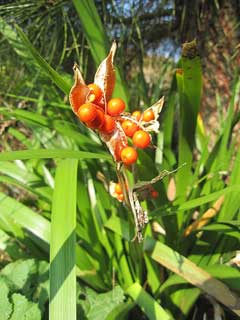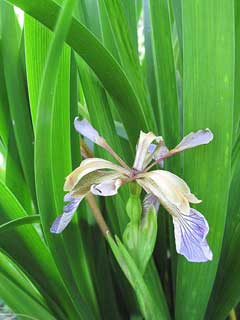 |
|
http://commons.wikimedia.org/wiki/User:Calimo |
 |
| http://commons.wikimedia.org/wiki/User:Calimo |
Translate this page:
Summary
Bloom Color: Purple, Yellow.
Main Bloom Time: Early summer, Late spring, Mid summer. Form: Upright or erect.
Physical Characteristics

 Iris foetidissima is an evergreen Perennial growing to 1 m (3ft 3in) by 1.5 m (5ft) at a medium rate.
Iris foetidissima is an evergreen Perennial growing to 1 m (3ft 3in) by 1.5 m (5ft) at a medium rate.
See above for USDA hardiness. It is hardy to UK zone 6 and is not frost tender. It is in leaf all year, in flower from May to July, and the seeds ripen from October to February. The species is hermaphrodite (has both male and female organs) and is pollinated by Bees. The plant is self-fertile.
Suitable for: light (sandy), medium (loamy) and heavy (clay) soils and prefers well-drained soil. Suitable pH: mildly acid, neutral and basic (mildly alkaline) soils and can grow in very alkaline soils.
It can grow in full shade (deep woodland) semi-shade (light woodland) or no shade. It prefers dry moist or wet soil and can tolerate drought. The plant can tolerate maritime exposure.
UK Hardiness Map
US Hardiness Map
Synonyms
Plant Habitats
Woodland Garden Sunny Edge; Dappled Shade; Shady Edge; not Deep Shade; Ground Cover; Hedgerow; Bog Garden;
Edible Uses
References More on Edible Uses
Medicinal Uses
Plants For A Future can not take any responsibility for any adverse effects from the use of plants. Always seek advice from a professional before using a plant medicinally.
Anodyne Antispasmodic Cathartic
Stinking gladwin has a long history of medicinal use, though it can be rather strong in its action and so is little used nowadays[244]. The root is anodyne, antispasmodic and cathartic[4, 61]. A decoction of the roots acts as a strong purge, it has also been used as an emmenagogue and for cleaning eruptions[4]. The powdered or infused dried root is beneficial in the treatment of fainting, nervous complaints and to relieve pains and cramps[4, 244]. The plant has been used as a cure for ringworm[240].
References More on Medicinal Uses
The Bookshop: Edible Plant Books
Our Latest books on Perennial Plants For Food Forests and Permaculture Gardens in paperback or digital formats.

Edible Tropical Plants
Food Forest Plants for Hotter Conditions: 250+ Plants For Tropical Food Forests & Permaculture Gardens.
More

Edible Temperate Plants
Plants for Your Food Forest: 500 Plants for Temperate Food Forests & Permaculture Gardens.
More

More Books
PFAF have eight books available in paperback and digital formats. Browse the shop for more information.
Shop Now
Other Uses
A good ground cover plant, succeeding in dense shade and in dry soils[197]. Rather slow to spread though, needing weeding for the first year or two[197]. Plants should be spaced about 60cm apart each way[208].
Special Uses
Ground cover Scented Plants
References More on Other Uses
Cultivation details
Landscape Uses:Border, Rock garden, Specimen. An easily grown and very tolerant plant, it succeeds in most positions in any good soil in sun or partial shade[79, 233]. Succeeds in dense shade. Prefers a moist soil[4] but succeeds in dry soils and, once established, is drought tolerant[190]. Thrives in a bog garden[188]. Requires a well-drained soil containing some lime[1] and succeeds on pure chalk[233]. Established plants are tolerant of considerable neglect and can survive dense weed competition[K]. The evergreen leaves are not very hardy, being killed back by cold winds around -15°c[187], though the rootstock is much hardier and the plant soon recovers in spring. A good plant for woodland edges[24]. Plants often self-sow[208, K]. There are some named forms, selected for their ornamental value[190]. The crushed leaves emit a strong odour which, at a distance, resembles hot roast beef[4]. On closer acquaintance the scent becomes disagreeable[4]. Members of this genus are rarely if ever troubled by browsing deer or rabbits[233]. Special Features:
Flowers have an unpleasant odor, Attractive flowers or blooms.
References Carbon Farming Information and Carbon Sequestration Information
Temperature Converter
Type a value in the Celsius field to convert the value to Fahrenheit:
Fahrenheit:
The PFAF Bookshop
Plants For A Future have a number of books available in paperback and digital form. Book titles include Edible Plants, Edible Perennials, Edible Trees,Edible Shrubs, Woodland Gardening, and Temperate Food Forest Plants. Our new book is Food Forest Plants For Hotter Conditions (Tropical and Sub-Tropical).
Shop Now
Plant Propagation
Seed - best sown as soon as it is it is ripe in a cold frame[4]. Stored seed should be sown as early in the year as possible in a cold frame, it may take 18 months to germinate. Prick out the seedlings into individual pots when they are large enough to handle and grow them on in the greenhouse or cold frame for their first year. Plant out into their permanent positions in late spring or early summer. Division, best done in July after flowering. Very easy, larger clumps can be replanted direct into their permanent positions, though it is best to pot up smaller clumps and grow them on in a cold frame until they are rooting well. Plant them out in the spring.
Other Names
If available other names are mentioned here
Native Range
EUROPE: United Kingdom, Italy (incl. Sardinia, Sicily), Spain, France (incl. Corsica), Portugal AFRICA: Algeria, Morocco
Weed Potential
Right plant wrong place. We are currently updating this section.
Please note that a plant may be invasive in one area but may not in your area so it's worth checking.
Conservation Status
IUCN Red List of Threatened Plants Status :

| Related Plants
|
| Latin Name | Common Name | Habit | Height | Hardiness | Growth | Soil | Shade | Moisture | Edible | Medicinal | Other |
| Albizia lebbeck | Siris Tree, Woman's Tongue, East Indian Walnut | Tree | 15.0 |
10-11
| F | LMH | N | DM | 1 | 2 | 4 |
| Albizia lucidior | Potka siris tree | Tree | 15.0 |
10-12
| F | LMH | SN | M | 0 | 0 | 3 |
| Albizia procera | White Siris, Tall Albizia, Forest Siris | Tree | 25.0 |
10-12
| F | LMH | N | M | 1 | 2 | 4 |
| Bobartia indica | Rush Iris | Perennial | 0.6 |
7-10
| S | L | N | DM | 0 | 0 | 1 |
| Gynandriris sisyrinchium | Spanish Nut | Perennial | 0.2 |
7-10
| | MH | SN | DM | 1 | 0 | |
| Iris cristata | Crested Iris, Dwarf crested iris | Perennial | 0.2 |
5-9
| M | LM | SN | M | 1 | 1 | |
| Iris decora | | Perennial | 0.3 |
-
| | LM | N | DM | 0 | 1 | |
| Iris douglasiana | Mountain Iris, Douglas iris | Perennial | 0.3 |
6-9
| | LM | SN | DMWe | 0 | 0 | 1 |
| Iris ensata | Japanese Water Iris | Perennial | 0.6 |
5-8
| M | LM | N | MWe | 1 | 1 | 2 |
| Iris filifolia | | Bulb | 0.5 |
-
| | LM | N | DM | 1 | 0 | |
| Iris germanica | Purple Flag, German iris, Orris-root, Tall Bearded German Iris, Bearded Iris | Perennial | 1.0 |
4-10
| M | LM | SN | DM | 1 | 3 | 2 |
| Iris germanica florentina | Orris, Orris-root | Perennial | 0.9 |
5-10
| M | LM | SN | M | 1 | 3 | 3 |
| Iris japonica | | Perennial | 0.6 |
-
| | LM | SN | DM | 1 | 2 | 3 |
| Iris kemaonensis | | Perennial | 0.5 |
-
| | LM | SN | DM | 0 | 2 | |
| Iris macrosiphon | Bowltube Iris | Perennial | 0.2 |
-
| | LM | SN | M | 0 | 1 | 1 |
| Iris missouriensis | Rocky Mountain Iris | Perennial | 0.8 |
0-0
| | LM | SN | MWe | 1 | 2 | 1 |
| Iris pallida | Dalmation Iris, Sweet iris, Fragrant Iris, Zebra Iris | Perennial | 1.0 |
4-10
| M | LM | SN | DM | 2 | 1 | 3 |
| Iris pseudacorus | Yellow Flag, Paleyellow iris | Perennial | 1.5 |
5-8
| M | LM | SN | MWeWa | 1 | 2 | 2 |
| Iris purdyi | Purdy's Iris | Perennial | 0.4 |
-
| | LM | SN | DM | 0 | 0 | 1 |
| Iris sanguinea | Blood iris | Perennial | 0.8 |
5-9
| | LM | SN | MWe | 0 | 1 | 1 |
| Iris setosa | Beachhead Iris, Canada beachhead iris, Wild flag | Perennial | 0.6 |
4-8
| M | LM | SN | MWe | 1 | 1 | 1 |
| Iris sibirica | Siberian Iris | Perennial | 0.6 |
4-9
| F | LM | SN | MWe | 1 | 1 | 1 |
| Iris tectorum | Roof Iris, Wall iris, Japanese Roof, White Root Iris | Perennial | 0.3 |
5-9
| M | LM | SN | DM | 1 | 0 | |
| Iris tenax | Tough-Leaf Iris, Klamath iris | Perennial | 0.3 |
0-0
| | LM | SN | DM | 0 | 1 | 2 |
| Iris versicolor | Blue Flag, Harlequin blueflag | Perennial | 0.6 |
4-8
| | LM | SN | MWe | 0 | 3 | 2 |
| Solanum tuberosum | Potato, Irish potato | Perennial | 1.0 |
7-10
| | LMH | N | M | 5 | 2 | 3 |
| Tagetes filifolia | Irish Lace | Annual | 0.4 |
8-11
| F | LMH | N | DM | 1 | 0 | 2 |
|
Growth: S = slow M = medium F = fast. Soil: L = light (sandy) M = medium H = heavy (clay). pH: A = acid N = neutral B = basic (alkaline). Shade: F = full shade S = semi-shade N = no shade. Moisture: D = dry M = Moist We = wet Wa = water.
Now available:
Food Forest Plants for Mediterranean Conditions
350+ Perennial Plants For Mediterranean and Drier Food Forests and Permaculture Gardens.
[Paperback and eBook]
This is the third in Plants For A Future's series of plant guides for food forests tailored to
specific climate zones. Following volumes on temperate and tropical ecosystems, this book focuses
on species suited to Mediterranean conditions—regions with hot, dry summers and cool, wet winters,
often facing the added challenge of climate change.
Read More
Expert comment
Author
L.
Botanical References
17200
Links / References
For a list of references used on this page please go here
Readers comment
© 2010, Plants For A Future. Plants For A Future is a charitable company limited by guarantee, registered in England and Wales. Charity No. 1057719, Company No. 3204567.